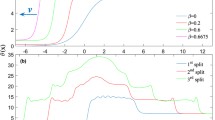Abstract
Simulations of arrays of resistively shunted Josephson junctions containing a crack of uncoupled junctions indicate that the crack can distort the supercurrent flow and provide a nucleation site at the crack tip for the formation of superconducting vortices at applied currents below the critical current of the homogeneous material. An analogy is established between the supercurrent distribution in two dimensions and the stress field distribution around the crack for antiplane mechanical loading. The analogy is used to show that the supercurrent distribution can be described analytically in terms of a Westergaard function used in elasticity theory. In addition, using a correspondence between the forces acting on a vortex and a crystal dislocation, models for screw dislocation emission from a crack tip are transposed to describe vortex emission from a crack tip. These lead to predictions for the pinning force required to prevent dissipation by vortex emission from the crack tip, as well as for the size of a vortex zone ahead of the crack for different values of the ratio of the applied current to the pinning force.
Similar content being viewed by others
References
E. Olsson, A. Gupla, M.D. Thouless, and D.R. Clarke, Appl. Phys. Lett. 58, 1682 (1991).
U.S. Hellman, E. H. Hartford, and K. M. Gyorgy, Appl. Phys. Lett. 58, 1335 (1991).
T. M. Shaw, S. L. Shindc, D. Dimos. R. F. Cook. P. R. Duncombc, and C. Kroll. J. Mater. Res. 4, 248 (1989).
D. R. Clarke. T. M. Shaw, and D. Dimes, J. Am. Ceram. Soc. 72, 1103 (1989).
A.G. Kvans, Acta Metall. 26, 1845 (1978).
D.R. Clarke, Acta Metall. 28, 913 (1980).
S.G. Kim and P.M. Duxbury. J. Appl. Phys. 70, 3164 (1991).
W. Xia and P. L. Leath, Phys. Rev. Lett. 63, 1428 (1989).
P. Haasen, Contemporary Physics 18, 373 (1977).
H.R. Hilzinger. Philos. Mag. 36, 225 (1977).
J. R. Clem, Physica C 153–155, 56 (1988).
D. Dimos, J. Mannhart. and P. Chaudhari, Phys. Rev. B 41, 4038 (1990).
C.S. Nichols and D.R. Clarke, Acta Metall. 39, 995 (1991).
D.E. McCumber, J. Appl. Phys. 39, 3113 (1968).
W.C. Stewart, Appl. Phys. Lett. 12, 277 (1968).
M. Tinkham. Introduction to Superconductivity (R. E. Krieger, New York, 1980).
T. Van Duzer and C. W. Turner, Principles of Superconductive Devices and Circuits (Elsevier, New York, 1981).
H.M. Westergaard. J. Appl. Mech. 6, 49–53 (1939).
H. Tada, P. C. Paris, and G. R. Irwin, The Stress Analysts of Cracks Handbook (Del Research, 1978).
G.C. Sih, Handbook of Stress Intensity Factors (Institute of Fracture and Solid Mechanics, Lehigh University, Bethlehem, PA).
J. R. Rice. J. Appl. Mech. 35, 379 (1968).
J. R. Rice and R. M. Thomson, Philos. Mag. 29, 73 (1974).
P.G. de (iennes, Superconductivity of Metals and Alloys (W. A. Benjamin. New York, 1966).
J. P. Hirth and J. Lothe, Theory of Dislocations (McGraw-Hill. New York. 1968).
M.O. Peach and J.S. Kochler, Phys. Rev. 80, 436 (1950).
R.M. Thomson, Solid State Phys. 39, 1 (1986).
Y-H. Chiao and D.R. Clarke, Acta Metall. 37, 203 (1989).
M. Tinkham and C.J. Lobb, Solid State Phys. 42, 91 (1989).
B.A. Bilby, A. H. Cottrell, and K. H. Swindcn, Proc. R. Soc. A 272, 304 (1963).
B. A. Bilby and J. D. F.shelby, in Fracture, edited by H. Leibowitz, 1, 99.
J.D. Livingston, Phys. Status Solidi 44, 295 (1977).
P.J. Lce and D.C. I.arbalcstier, Acta Mctall. 35, 2523 (1987).
A.M. Campbell and J. E. Evetts, Adv. Phys. 21, 199 (1972).
R. Labusch, Crystal Lattice Defects 1, 1 (1969).
E.J. Kramer, J. Appl. Phys. 41, 621 (1971).
E.J. Kramer, J. Appl. Phys. 44, 1360 (1973).
H. Trauble and U. Essmann. J. Appl. Phys. 39, 4052 (1968).
U. Essmann and H. Trauble. Phys. Status Solidi 32, 337 (1969).
C. Herring, Phys. Lett. A 47, 105 (1974).
G.J. Dolan, G. V. Chandrashekhar, T. R. Dinger, C. Leild. and F. Hollzberg, Phys. Rev. Lett. 62, 827 (1989).
N.V. Sarma. Phys. Lett. A 25, 315 (1967).
U. Krageloh, Phys. Status Solidi 42, 559 (1970).
M.R. Beasley, R. Labusch, and W.W. Webb. Phys. Rev. 181, 682 (1969).
J.R. Rice, J. Mech. and Phys. Solids 40, 239 (1992).
Author information
Authors and Affiliations
Rights and permissions
About this article
Cite this article
Clarke, D.R., DeGraef, M. The effect of cracks on the superconducting transport current in thin films: The analogy with two-dimensional elasticity and plasticity. Journal of Materials Research 8, 1515–1532 (1993). https://doi.org/10.1557/JMR.1993.1515
Received:
Accepted:
Published:
Issue Date:
DOI: https://doi.org/10.1557/JMR.1993.1515




